Revised 28 April 2022
Accepted 24 October 2022
Available Online 21 November 2022
- DOI
- https://doi.org/10.55060/s.atssh.221107.023
- Keywords
- Shang Deyi
Coloratura art songs
Nationality - Abstract
Shang Deyi was a representative composer in the field of contemporary coloratura art song creation and was known as “the first person in coloratura creation in China”. Shang Deyi had conducted more and more in-depth analysis and research on colora vocal works and had his own unique creative opinions. In his creation, he skillfully integrated Western creation techniques with the style of Chinese folk music, and his typical “nationality” creation features are of pioneering significance in China. The coloratura art songs he created are rich in musical styles, distinctive in nationality and are sung by a large number of vocal music learners. This article focuses on the analysis and discussion of the national creative characteristics of the three representative coloratura vocal works composed by Shang Deyi, “The Prairie in July”, “The Millennium Sago Cycas Blossoms” and “The Joy of the Torch Festival”, to provide peers theoretical basis and reference value.
- Copyright
- © 2022 The Authors. Published by Athena International Publishing B.V.
- Open Access
- This is an open access article distributed under the CC BY-NC 4.0 license (https://creativecommons.org/licenses/by-nc/4.0/).
1. INTRODUCTION
Coloratura [1] singing is based on the form of Organon's chant, and the singing technique is smooth, beautiful, smart and sweet. After coloratura singing was introduced into China from the West, it was combined with the traditional vocal art of China, and many outstanding composers such as Shang Deyi and Hu Tingjiang1 appeared. At the same time, “The Prairie in July”, “Mayila Variations” and other well-known works also appeared in front of the public. The coloratura art songs they created combine the characteristics of the times, interpret the thoughts and emotions of ordinary people against the background of the times through the close combination of melody and lyrics, and express people's yearning and pursuit for a happy life.
Shang Deyi (1932-2020) was a well-known contemporary composer and music educator in China, known as “the first person in Chinese coloratura creation” and leader of coloratura music creation [2]. In the creation of art songs, his content and forms were very diverse, the subject matter extensive, and ideological connotations profound, which provided many references for people to learn the creation skills of art songs. He created many classical colora vocal works, skillfully combining national characteristics with Western European classical romantic style, with typical diverse national characteristics. His works occupy a very important position in the history of Chinese music creation. His personal creation style is strong and his works are unique. In the process of creation, he fully absorbed the “nationalized” music creation of various regions and ethnic minority folk songs and folk dance music elements, which is a typical presentation of the “Sinicized” musical language of his coloratura works [3].
2. XINJIANG STYLE: “THE PRAIRIE IN JULY”
2.1. Introduction of the Work
“The Prairie in July” is a coloratura vocal work with strong Xinjiang ethnic customs. Song Binting wrote the lyrics and Shang Deyi composed the music. The theme of this song is inspired by the Xinjiang Uyghur prairie, using the notes and lyrics as a medium to convey the fresh and holy natural scenery of the Xinjiang prairie to the hearts of the singers and listeners. Shang Deyi used the musical elements of the Xinjiang national style in his creation. He skillfully combined lyrical melody and coloratura melody, and used the language of music to depict a charming watercolor painting of the midsummer grassland [4].
2.2. National Characteristics of Melody Techniques
The musical structure of “The Prairie in July” is a single two-part composition. The melody of the whole piece has a strong Xinjiang national style, and the rhythm has strong dance quality. The cheerful melody is combined with the gorgeous color tune into one piece, which perfectly shows the national customs of the Uyghur people singing and dancing. The national character of the melody technique in the song is firstly reflected in the national characteristic rhythm pattern of the song. Shang Deyi used the “Mexirepu rhythm pattern”2 in his creation, which is a unique national characteristic rhythm of Uyghur music. It is characterized by being cheerful and powerful, which can well set off the cheerful atmosphere on the grassland. Shang Deyi ingeniously designed the rhythm combination, combining the basic frets of “Messyrep rhythm pattern”:  and the variant:
and the variant:  are combined to absorb the characteristics of this rhythm combination, and based on this, the mood conveyed by the lyrics is improved
are combined to absorb the characteristics of this rhythm combination, and based on this, the mood conveyed by the lyrics is improved  , and runs through the song (Fig. 1, Example 1-1).
, and runs through the song (Fig. 1, Example 1-1).
The melody expression form of “The Prairie in July” is mainly composed of lyrical melody, supplemented by coloratura melody. The most representative parts of the lyrical melody are bars 10-21, 30-38 and 59-67.
For example, in Fig. 1 (Example 1-1), the first bar starts from the tonic and goes up and down, and then the second bar goes down; the third bar uses a fourth jump, and the melody fluctuates and fluctuates, which makes the melody more vivid; finally, the fourth bar phrase ends with the tonic.
The 39-48 bars are a lyrical melody that starts, turns and ends with the word “ah” from crescendo to crescendo. The melody is meaningful and full of the Uyghur people's love and pride for the grasslands. Two short sentences show the rhythm completely.
The most representative parts of the colora melody are bars 24-27, 49-50 and 55-58 of the song.
Bars 22-29 (Fig. 2, Example 1-2) are composed of long tones to connect the color-tuning and short jumps. The jumps are added to the melody of the long sentence. The rhythm is bright and brisk, which outlines a beautiful landscape painting of “the grassland is full of vitality, girls and boys dance, and racehorses”. It not only enriches the melody, but also makes the Uyghur national characteristics of the whole song more intense.
Bars 55-58 (Fig. 3, Example 1-3) use rests and big jumps, reflecting rhythmic characteristics of Uyghur folk dances. The descending scales of two consecutive bars in bars 57-58 make an emotional foreshadowing for the introduction of the climax of the whole piece.
2.3. National Characteristics of Accompaniment Textures
In the creation of “The Prairie in July”, Shang Deyi not only applied the national characteristics of Uyghur music to the melody technique, but also applied it to the accompaniment textures, which mainly reflected in the following aspects:
Firstly, bars 1-9 in the song: The first nine bars are the prelude of the song, and the bass and melody parts both use the octave playing technique. The rhythm of the bass part is  , which is a typical ethnic rhythm of the Uyghur people and is full of rhythm. It brings singers and listeners step by step into the beautiful wilderness scenery of the Xinjiang prairie in summer; Bar 8 changes the accompaniment pattern in preparation for the introduction of bar 9 (Fig. 4, Example 1-4).
, which is a typical ethnic rhythm of the Uyghur people and is full of rhythm. It brings singers and listeners step by step into the beautiful wilderness scenery of the Xinjiang prairie in summer; Bar 8 changes the accompaniment pattern in preparation for the introduction of bar 9 (Fig. 4, Example 1-4).
Second, bars 10-21 of the song: The piano accompaniment texture in this part mainly uses the chords of the melody part and the octave of the bass part. In order to express the artistic conception of singing and dancing on the grasslands expressed by the song, it is necessary to pay attention to playing the chords of the right hand with repeated chords in skips, and the last beat of which is maintained. This kind of accompaniment texture can better integrate the lyrics content with the melody, and strengthen the national characteristics of the melody.

“The Prairie in July” bars 10-13 (Example 1-1). From [5].

“The Prairie in July” bars 22-29 (Example 1-2). From [5].

“The Prairie in July” bars 55-58 (Example 1-3). From [5].
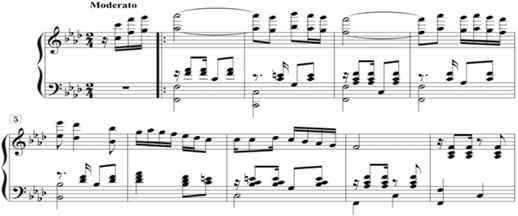
“The Prairie in July” bars 1-9 (Example 1-4). From [5].
Third, bars 22-38 of the song: The piano accompaniment texture in this part mainly adopts the accompaniment structure that combines three parts at the same time, i.e. left hand plays the octave, and right hand plays the corresponding syncopation pattern. In the 25th bar, Shang Deyi filled in the long notes with tight sixteenth notes, echoing the melody of the song, making it more fluid and aesthetic.
Fourth, bars 39-67 of the song: The texture of the piano accompaniment in this part focuses on the expression of emotion, using two different accompaniment forms. The first is the use of the previous three-part accompaniment structure, and the second is the short arpeggio method. The appearance of arpeggios makes the melody more lively and light, stretches the mood, and gradually leads to the climax of the whole song. Bars 66 and 67 use staccato to play the octave pattern [6].
3. NORTHEAST FOLK SONG STYLE: “THE MILLENNIUM SAGO CYCAS BLOSSOMS”
3.1. Introduction of the Work
“The Millennium Sago Cycas Blossoms” is a colora vocal work with the characteristics of northeastern folk songs. Written by Wang Zhuo and composed by Shang Deyi, it was created in 1971 of the last century. It is a piece of music that uses Western coloratura creation techniques to reflect the theme of the real life of Chinese people's society. This piece is Shang Deyi's first publicly published coloratura vocal work, and it has been sung for 40 years without fading. It was the only coloratura song approved for release at the time, and was later adapted for violin solo. The theme of the song is taken from the story of the doctors of the People's Liberation Army who worked hard to study acupuncture and moxibustion techniques of traditional Chinese medicine, and deaf-mute man regained life and spoke after receiving acupuncture.
3.2. National Characteristics of Melody Techniques
The musical range of “The Millennium Sago Cycas Blossoms” is large, reaching more than two octaves. Nearly one-third of the song is coloratura, which has high technical requirements for singers. It is the first milestone in the creation of Shang Deyi's coloratura art songs. This piece skillfully uses the traditional national mode pentatonic scale, and the composition is a multi-segment structure (ABCDA) common in traditional national music.
The national character of song melody and technique is first reflected in the national characteristic rhythm pattern. Shang Deyi used the common rhythm patterns  and
and  in Chinese national gong and drum music in “The Millennium Sago Cycas Blossoms” (Fig. 5, Example 2-1). On the one hand, the use of this rhythm pattern can be combined with other rhythm patterns to enhance the artistic conception and atmosphere of the song, and secondly, it can also increase the northeastern folk song style characteristics of the song. At the same time, it is also a song with distinctive characteristics of the times. Shang Deyi mostly used the short-jump sound with typical national characteristics in the no-word coloratura part of the song. Through the gradual progression and increase of the colora part, the melody is brought into the climax.
in Chinese national gong and drum music in “The Millennium Sago Cycas Blossoms” (Fig. 5, Example 2-1). On the one hand, the use of this rhythm pattern can be combined with other rhythm patterns to enhance the artistic conception and atmosphere of the song, and secondly, it can also increase the northeastern folk song style characteristics of the song. At the same time, it is also a song with distinctive characteristics of the times. Shang Deyi mostly used the short-jump sound with typical national characteristics in the no-word coloratura part of the song. Through the gradual progression and increase of the colora part, the melody is brought into the climax.
Section A is drawn from the introduction, and the lining word “ah” is used to express emotions. From the 23rd bar to the 24th bar, the rhythm changes from a quarter note to a sixteenth note at the beginning, and the colora part appears lightly, emotionally reflecting the incomparably excited emotions of the deaf-mute after speaking.
The emotions of Section B changed from joy to depression. Through the comparison between the past and the present, it recalled the agony of the deaf and dumb people in the past. At the end, the emotions turned back to the excitement, and the emotions of Part C were inherited.
The joyful emotional color of the C section echoes the A section, and the speed is correspondingly faster. The clear melody matches the meaningful lyrics, and the phrase “the east wind sends warmth, the red flag reflects the colorful clouds” sings the arrival of hope. A large part of the flower chamber part of the D section uses the method of four-tone moulding, and the emotions gradually enter. The emotional climax of the piece is the appearance of the scattered cadenza.
Finally, under the rendering of emotions, the music returns to Section A of the reproduction part.

“The Millennium Sago Cycas Blossoms” bars 21-23 (Example 2-1). From [5].
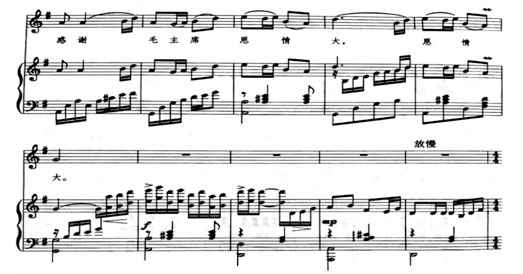
“The Millennium Sago Cycas Blossoms” bars 25-34 (Example 2-2). From [5].
3.3. National Characteristics of Accompaniment Textures
Shang Deyi not only applied national characteristics of Uyghur music to the melody technique, but also applied it to the accompaniment texture, which mainly reflected in the following aspects:
First, about the piano accompaniment, the composer designed the conversion of sixteenth note to eighth note at the end of the song A section, so that the mood of the song develops from high to low, and it also plays a role in the transition of the subsequent theme to narrative (Fig. 6, Example 2-2).
Second, at the connection between the B and C sections of the song, the composer used the piano accompaniment a compact and coherent sixteenth note, changing the rhythm from 4/4 to 2/4 (Fig. 7, Example 2-3).
Third, the end of Section C is the climax of the whole piece. The piano accompaniment’s columnar chord progression and reverse progression make the music image more vivid and rich, and it also promotes the emotional development of the song to a climax (Fig. 8, Example 2-4).
Fourth, in the reproduction of Section A, the piano accompaniment again uses a continuous and tight triplet pattern, which brings out the highest emotion of the musical theme and enhances the sense of termination at the end (Fig. 9, Example 2-5).
The rhythm of the piano accompaniment part of the piece imitates the rhythm of the melody part. The cooperation of the two in and out and echoing each other makes the rhythm and tempo full of the sense of pause and transition. At the same time, it also shows the straightforward and upright style characteristics of Northeast folk songs more clearly [7].

“The Millennium Sago Cycas Blossoms” bars 43-45 (Example 2-3). From [5].
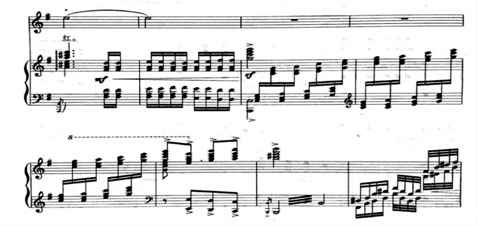
“The Millennium Sago Cycas Blossoms” bars 73-80 (Example 2-4). From [5].
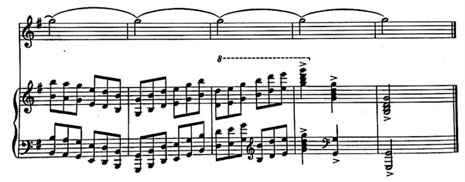
“The Millennium Sago Cycas Blossoms” bars 130-134 (Example 2-5). From [5].
4. YI STYLE: “THE JOY OF THE TORCH FESTIVAL”
4.1. Introduction of the Work
“The Joy of Torch Festival” is a colora vocal work with distinctive Yi style. The lyrics were composed by Lu Yunsheng and the music by Shang Deyi. It was created in 1981. The song not only reflects the fusion of Western coloratura creation techniques and elements of Yi folk songs, but also reflects the happy life scene of the Yi people celebrating the Torch Festival and living and working in peace and contentment. Legend has it that “fire” is a symbol of hope and beauty for the Yi people, and the Torch Festival carries the Yi people's yearning for a better life in the future. Through the charm of music, Shang Deyi showed the unique national style of the Yi people.
4.2. National Characteristics of Melody Techniques
“The Joy of Torch Festival” is an art song with a light rhythm and a sense of rhythm. The music structure of the song is a complex trilogy with reproduction [8].
The rhythm of the song is full of strong Yi style, using the typical “short and long dotted”3 rhythm in Yi music. In the introduction of the six bars of the prelude, half notes and quarter notes are used in the first and second bars respectively, which are used to imitate the rhythm and rhythm of Yi horn music, and pave the way for the jubilant and warm emotional atmosphere of the song. From the third measure onwards, the first eight and last sixteen notes and eighth notes are used to simulate the rhythm of the drums of Yi nationality music (Fig. 10, Example 4-1).
The first part (bars 7-22) can be divided into two sections, A and B. Section A is composed of two parallel phrases. Shang Deyi chose the national pentatonic mode in his creation, and referenced Western composition techniques to coordinate his creation, in order to reflect the national characteristics of melody techniques. Section B is the expansion of Section A. The upward melody that jumps into the first two phrases makes the music more emotional, and the entire melody line is more expressive than Section A (Fig. 11, Example 4-2).
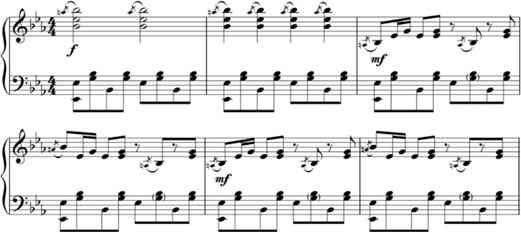
“The Joy of the Torch Festival”, introduction section, bars 1-6 (Example 4-1). From [5].

“The Joy of the Torch Festival” bars 16-18 (Example 4-2). From [5].

“The Joy of the Torch Festival”, colorati excerpts, bars 28-30 (Example 4-3). From [5].
The middle part (bars 27-50) is transferred to the B Gong mode of the same Gong system in the connecting sentence (bars 23-26), and the same #G Yu mode is used interchangeably, with bright tonal colors. The rhythm is changed from compact notes to longer notes, which are more telling, opening the curtain for the subsequent emotional unfolding. The melody of the coloratura Cadenza is lively, lively, and full of jumping sense. Through the gradual progression of the melody, the emotional atmosphere of the song is gradually pushed to a climax. At the same time, it is also full of Yi people's yearning and longing for a happy life, reflecting the national charm and color of the song (Fig. 12, Example 4-3).
The recapitulation (bars 7-22) is a complete reproduction of the first part of the song. The melody echoes the theme of the song, and the rhythm consolidates the rhythm and rhythm of Yi music. The melody of the closing sentence has been raised octave, forming a strong sense of termination, making the musical image of the whole song more unified, and sublimating the artistic conception of the song.
4.3. National Characteristics of Accompaniment Textures
The importance of the texture of the piano accompaniment to the piece “The Joy of the Torch Festival” cannot be underestimated. It echoes the human voice and reflects the national characteristics of the whole piece to a greater extent.
The intro part (bars 1-6) uses cylindrical chords as introduction (Example 4-1) to simulate the sound of festival gongs and drums. Furthermore, the addition of split and rest rhythm is full of dance rhythm, which sets off the warm atmosphere of the festival.
The first section (bars 7-22) A section uses a series of arpeggios combined with a syncopated rest rhythm (Fig. 13, Example 4-4), which has a strong narrative. Section B uses a combination of cylindrical chords and arpeggios to express the festive atmosphere of the Torch Festival (Fig. 14, Example 4-5). The wavy melody lines shape the straightforward and forthright character of the Yi people on the score.
The middle part (bars 27-50) is characterized by a transition and transition, with arpeggios as transitional connections at first, and then column chords as accompaniment textures (Fig. 15, Example 4-6). After the modulation, a variety of accompaniment texture combinations are used, which reflects the musical color tone of the main melody.
The coda part (bars 57-68) uses arpeggios to form a cadenza on the basis of an octave-raised melody. The melody and rhythm of the whole part correspond to the first part, which is the sublimation of the whole song's emotion, making the happy picture of the Torch Festival in front of people.

“The Joy of the Torch Festival” bars 9-10 (Example 4-4). From [5].

“The Joy of the Torch Festival” bars 16-18 (Example 4-5). From [5].

“The Joy of the Torch Festival” bars 31-33 (Example 4-6). From [5].
5. CONCLUSION
Inspired by the different national languages, cultures and aesthetics of China, Shang Deyi created Chinese-style coloratura art songs with distinctive national characteristics, which further improved the artistic sense and expressiveness of our national vocal music, and the majority of vocal music lovers have access to more storytelling and infectious vocal works. His research and induction in this area not only played a breakthrough role in the creation of Chinese national coloratura vocal music works, but also had practical and theoretical significance in the field of Chinese national vocal music performance and teaching, having an enlightening effect on the promotion and innovation of my country's national vocal music [9].
In the creation of melody techniques and the creation of piano accompaniment textures, the three works “The Prairie in July”, “The Millennium Sago Cycas Blossoms” and “The Joy of the Torch Festival” fully demonstrate their superb coloratura creation skills and the soul of the “nationality” creative style. The research on the national characteristic analysis of Mr. Shang Deyi's melody technique and the national characteristic analysis of accompaniment texture in the coloratura vocal works has positive significance for the younger scholars to improve the deep cognition level of the works.
Shang Deyi integrated Western creative techniques with the style of Chinese folk music in music creation, and is a model of pursuing the perfect unity of form and content. The wide dissemination and popularity of his works also proves from the side that only works with “fireworks” created based on life, close to life, and eulogizing life can become excellent works loved by the people. Professor Shang Deyi had been indulging in music creation all his life, and he regarded his fame, fortune and wealth as clouds. When he was young, he was still obsessed with education, and he had pupils everywhere. Shang Deyi's life was just like his name says, “virtuous and righteous, and his name was like his person”, his creative concept that he did not forget his original intention is worth learning by future generations [10].
ACKNOWLEDGMENTS
The study was supported by “2021 Jiangxi Province Basic Education Research Project-Research on the Red Song Educating People Method of Moral Education + Aesthetic Education in Basic Education” (Grant No. SZUJJYI2021-1050) “2021 Jiangxi University Humanities and Social Sciences Research Project — Research on the Music Culture of Lantern Drama in Poyang Valley” (Grant No. YS21107) 2022 Jiangxi Provincial Educational Science Planning Project “Research on the Combination of Ganpo Music Culture Curriculum Construction and Mass Literature and Art Talent Cultivation under the Background of New Liberal Arts” (Grant No. 22YB224).
Footnotes
Hu Tingjiang (1981- ) is a young composer and associate professor of the Composition Department of China Conservatory of Music. Based on traditional folk music, he integrates western composition techniques into folk vocal works, perfectly interpreting the innovation of music. Representative works include “Spring Ballet”, “Our New Era” and so on.
The original meaning is “happy party”, which consists of three to six dances with different rhythms, no interludes, or even a passage longer than one festival.
“Short and long dotted rhythm pattern” is “small front dotted rhythm pattern”, and the notation is recorded as: 
REFERENCES
Cite This Article

TY - CONF AU - Simei Zhang AU - Dandan Zhou PY - 2022 DA - 2022/11/21 TI - Analysis of the “Nationality” Characteristics of Shang Deyi's Coloratura Art Songs: Taking Three Works as Examples BT - Proceedings of the 8th International Conference on Arts, Design and Contemporary Education (ICADCE 2022) PB - Athena Publishing SP - 131 EP - 139 SN - 2949-8937 UR - https://doi.org/10.55060/s.atssh.221107.023 DO - https://doi.org/10.55060/s.atssh.221107.023 ID - Zhang2022 ER -









